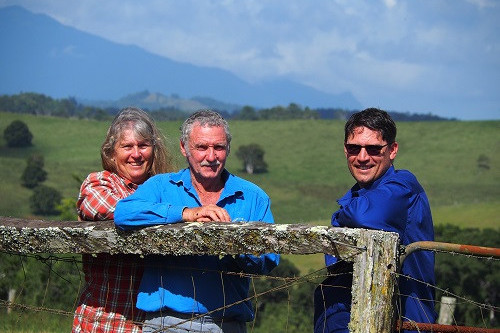Business
29 September, 2020
Petersen Family's All-Of-Farm Changes
A Tablelands grazing family has opened the floodgates for change on their property – and they can’t wait to see the long-term results.

Trevor and Jean Petersen, along with Trevor’s parents Ken and Connie, are working with natural resource management organisation Terrain NRM on a makeover that includes earthworks, tree-planting, fencing, a solar-powered water supply for cattle and a new way of managing pastures.
Trevor Petersen said the family chanced on the opportunity while looking for help with managing erosion problems along waterways running through their Malanda property of 10 years.
“An old cattle crossing was completely washed out and February floods took a section of bank out,’’ he said. “We lost a lot of soil down the creek – something had to be done.”
The Petersens now have a modified creek crossing after earthworks including bank re-shaping, rock and gravel placement. The family is now putting up fences either side of the crossing to keep cattle off more than a kilometre of water course.
Terrain NRM’s Vanessa Drysdale said 5000 trees and grasses would be planted along the waterway, a tributary flowing into Williams Creek and the North Johnstone River. She said an off-stream watering system with a tank and troughs connected to a solar pump was being installed, along with a modified grazing management plan for the farm.
“We do the earthworks and revegetation, and the Petersen family undertakes the fencing and installation of off-stream watering infrastructure,’’ she said. “The family is also responsible for implementing the grazing management practice changes.
“This combination will stop an estimated 120 tonnes of fine sediment a year from flowing into the Johnstone River – the equivalent of 15 to 20 truckloads. Changes on properties, however big or small they are, really make a difference.”
The work is part of the $2.3 million Upper Johnstone Integrated Project, funded by the Queensland Government’s Natural Resources Investment Program. It includes workshops for landholders on grazing systems, soil health and sustainable resource and business management.
Trevor said the Grazing Naturally series with Dick Richardson was changing his mindset on managing cattle and pastures.
“We usually run a cell grazing system here – rotating 40 head of cattle through 50 acres,’’ he said.
“Each of our paddocks has the same grazing pressure. Now we’ll have smaller paddocks and manage them differently. We’ll be doing things like grazing one more heavily while resting another, and looking at each paddock more closely to assess our pasture.
“The goal is a more environmentally-friendly way of working, for the land and water quality, without affecting productivity.”
The Johnstone River catchment is a priority for water quality improvement and has been given the Far North’s highest sediment reduction target in the Australian and Queensland Government’s Reef 2050 Water Quality Improvement Plan.
Ms Drysdale said the Upper Johnstone Integrated Project was “all about reducing sediment losses to the Great Barrier Reef lagoon while helping graziers to help themselves by managing erosion problems and improving their pastures and livelihoods’’.


